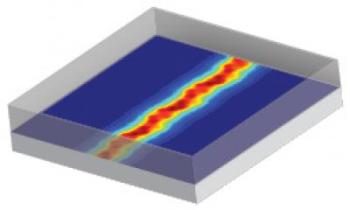Scientists from the Purdue University, Melbourne University and University of New South Wales have fabricated the smallest silicon-based wire in the world, with a current-conducting capability equivalent to that of copper wires. The silicon wire has four-atom width and one-atom height.
 Wires just one atom tall have been created by inserting a string of phosphorus atoms in a silicon crystal by a team of researchers from the University of New South Wales, Melbourne University and Purdue University. This image from a computational simulation run of the wires shows electron density as electrons flow from left to right. The wires are 20 times smaller than the smallest wires now available and measure just four atoms wide by one phosphorus atom tall. (Credit: Purdue University image/Sunhee Lee, Hoon Ryu and Gerhard Klimeck)
Wires just one atom tall have been created by inserting a string of phosphorus atoms in a silicon crystal by a team of researchers from the University of New South Wales, Melbourne University and Purdue University. This image from a computational simulation run of the wires shows electron density as electrons flow from left to right. The wires are 20 times smaller than the smallest wires now available and measure just four atoms wide by one phosphorus atom tall. (Credit: Purdue University image/Sunhee Lee, Hoon Ryu and Gerhard Klimeck)
Based on the experiments using atom-by-atom supercomputer models, the researchers have also demonstrated that the silicon-based wire retains a minimal capacity for resistance even though its thickness is 20 folds lesser than that of traditional copper wires used in microprocessors. They have published their findings in the Science journal.
These findings will help researchers to develop next-generation nanoscale computational devices. They will also realize the possibility of donor-atom based silicon quantum computing. They also demonstrate that Ohm's Law can be applicable down to an atomic-scale wire.
Gerhard Klimeck, who serves as Director of the Network for Computational Nanotechnology as well as Professor of electrical and computer engineering at Purdue University, stated that the innovation of Melbourne University researchers was a bottom-up approach wherein the circuits were built atom by atom, which is contrary to the existing microprocessor construction procedures wherein materials are removed.
Klimeck further said that the Australian team constructed devices by placing thin phosphorus atomic layers in silicon and discovered that the densely doped phosphorus wires having four-atom width behaved like a metallic wire that conducts electricity. Klimeck’s team helped the Australian team by running numerous simulations to understand the changeability of these nanoscale materials.
According to Michelle Simmons, who serves as the principal investigator of the project and the Director of the University of New South Wales’ Centre of Excellence for Quantum Computation and Communication Technology, the objective of the project is to design future quantum computers wherein single atoms can be utilized for the computation.